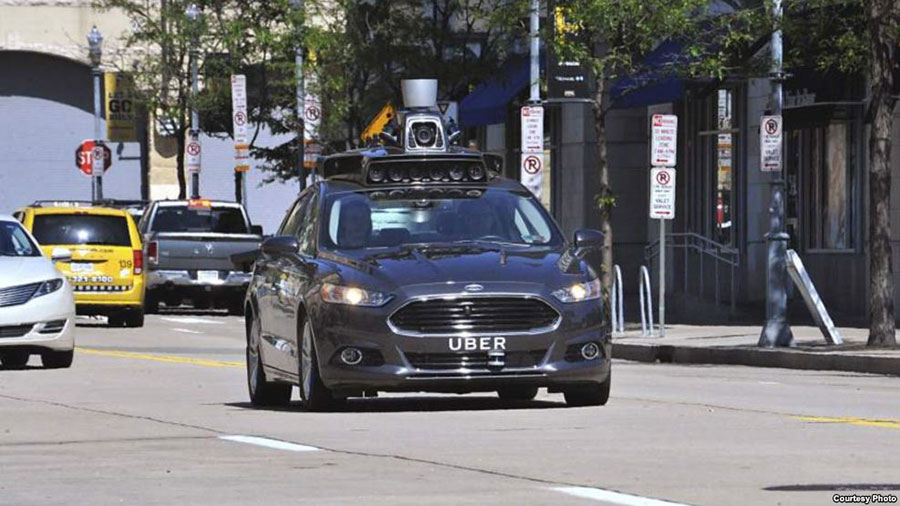Uber is resuming tests for its self-driving-car program this Monday in Pittsburgh and Arizona. On Friday they suspended the trials, following an accident that involved one of the autonomous vehicles.
The accident took place last Friday when one of the company’s self-driving Volvo SUVs flipped onto its side causing a collision in Tempe, Arizona. Photographs of the crash showed that a car in the background had dents and smashed windows. Uber’s car was operating in the self-driving mode when the accident occurred. Shortly after, Uber confirmed that no back-seat passengers were inside the vehicle.

Uber’s car was not responsible for crash in Arizona
A Tempe police spokeswoman talked to Business Insider about the accident. She said that the Uber car wasn’t responsible for the crash and that nobody suffered injured from the accident. The Uber car was hit when the other vehicle was unable to yield, which caused the SUV to flip over. The other car involved in the accident received a citation due to a moving violation.
The accident adds to the current debate on self-driving cars safety. For example, Google’s prototype self-driving car was involved in some accidents since its launch, and a Tesla car operating in autopilot participated in a crash last year that killed the other car’s driver.
After the accident, Uber suspended its self-driving-car tests in Arizona, Pittsburgh, and San Francisco. On Monday morning Uber lifted the suspension for tests in San Francisco, and later in the day, they lifted suspensions for Pittsburgh and Arizona.
In San Francisco Uber hasn’t started picking up passengers with the self-driving cars, they are currently only using two vehicles for mapping purposes, and they are driven manually by Uber drivers.

California DMV revoked Uber’s autonomous cars licenses
The company started its self-driving-car tests in Pittsburgh last September, and they have been picking up drivers in Ford Fusions retrofitted with Uber’s technology for self-driving cars. The ride service company attempted to conduct the same tests in San Francisco in December, but the California DMV raised issues for the tests.
Uber had not obtained an autonomous vehicle license before the launch. Consequently, the California DMV revoked the registration of 16 autonomous vehicles from Uber. The company had planned to use the self-driving Volvo XC90 SUVs for the Californian city tests.
Uber conducted tests for self-driving-cars in San Francisco for a week before having the permission revoked. During that week one of the cars was caught on video by a surveillance camera, showing the car passing a red light at a busy intersection. A representative from Uber explained that a human mistake caused the red-light infraction, but other Uber employees told The New York Times that the car was being self-driven.
Since January, the company has been using two Ford Fusions in San Francisco, which have the autonomous technology to map the routes of the city. However, none of the cars is being used in the self-driving mode. After the failed attempt on San Francisco, Uber sent the self-driven SUVs to Arizona, and they were taken there by one of the company’s self-driving trucks.

Uber’s sexist scandals
Uber is currently involved in a lawsuit regarding the self-driving technology. Alphabet’s self-driving-car company, Waymo, claims that Uber stole the designs for the LiDAR system, which is a key sensor that lets self-driving cars know when there is an obstacle nearby. Waymo filed an injunction and asked a federal judge to stop Uber’s use of the autonomous car technology.
The company was also involved in a sexist scandal when former Uber engineer Susan Fowler accused Uber of promoting a sexist workplace environment. Fowler published a blog post in February, addressing the harassment and gender bias that she claims she endured while working for the company.
“When I joined Uber, the organization I was part of was over 25% women,” wrote Fowler on the blog post. “By the time I was trying to transfer to another eng (engineer) organization, this number had dropped down to less than 6%. Women were transferring out of the organization, and those who couldn’t transfer were quitting or preparing to quit. There were two major reasons for this: there was the organizational chaos, and there was also the sexism within the organization.”
After Fowler’s blog post, The Times published a report detailing the events of an Uber company retreat, in which a manager groped some female colleagues. The report explained that the manager was fired following the company retreat. Another Times report said that Uber had been using a tool called Greyball, which helped to evade government regulators who were trying to block the company’s services.
Source: Business Insider
